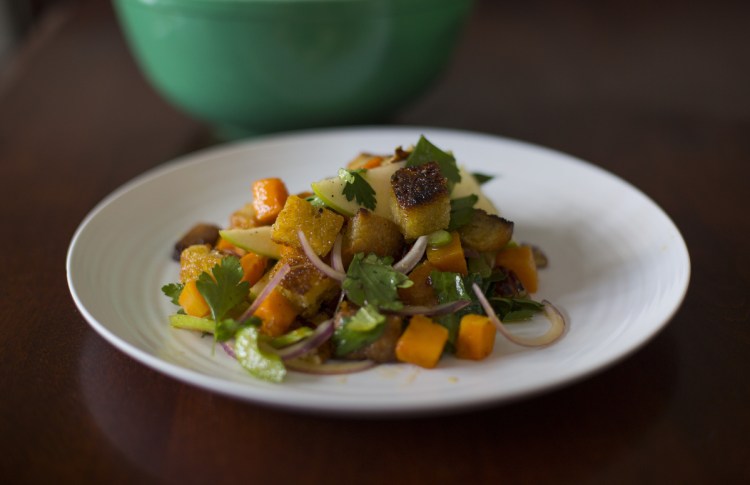I try not to take it personally that, after developing recipes professionally for 10 years now, my most requested recipe is for croutons. Yes, folks, that’s right. Not my salted pumpkin caramels. Not my flourless chocolate chip cookies. Not my lemon-lavender posset. People most often want to know my secret method for salvaging three-day old bread into something edible so that it doesn’t go to waste.
When I’m the mom who signs up to bring a Caesar salad to a sports team’s banquet potluck or to a theater troupe’s cast party, the kids see me coming with the croutons and descend upon them without a passing glance at the salad. As I stand on the sideline at a game or sit in the audience at a performance, parents ask me for the recipe because their kids rave about Mrs. Rudalevige’s croutons. Word gets around fast in Maine.
So here goes, folks. This may be the one and only time I spell out the recipe for making these croutons. Take 1 cup of old bread, cut it into cubes, fry it up in a hot pan with 2 tablespoons of whatever fat you have handy, use a slotted spoon to transfer the cubes from the pan to a flattened paper bag to drain and sprinkle them liberally with salt. That’s all she wrote.
Well, there are a few tips and tricks you might want to know before attempting this recipe.
Let’s talk about the bread: First, it must be old but not ancient. Fresh bread is too soft to give you the right crunch. Rock-hard, very stale bread is better grated into bread crumbs. Two-days old is perfect.
Second, these croutons cannot be made from mechanically sliced bread, because even if the crumb is right, those slices are generally too thin. You need a hearty bread – like a sourdough boule – that you can cut into 1-inch-thick slices and then into cubes. Ideally, only one side of each cube has a crust, more than that makes the crouton difficult to bite down on without scraping the roof of your mouth. Trust me on that.
Moving on to the fat… use canola, grapeseed, olive, safflower or sunflower oils, ghee or bacon fat. But stay away from plain old butter as it tends to burn too quickly here. The fat needs to be sizzling hot before the bread cubes hit it. When you dump the cubes into the pan, immediately jostle them around to coat them with fat on all sides.
At this point, it’s wise to think that bread cubes frying in a pan are like pears ripening in a bowl on the counter. You check them. They’re not ready. They’re not ready. They’re not ready. And then, boom, they are too far gone. Just like pears can go from rock hard to mushy if you’re not looking at the exact right moment, croutons go from not quite brown to burnt in a second flat. Be vigilant. The trick is to flip them all as soon as you see one turn golden brown. I use a wide spatula to make this happen quickly. You don’t have to worry that the side exactly opposite of the cooked side hits the pan, any uncooked side will do. The croutons are done when two sides of any cube of bread is golden brown; I stop at two sides to keep the croutons from toughening.
The last trick is to salt them while they are hot so some salt adheres to each crouton.
I don’t typically bother to store these crispy bread nuggets in either unsustainable plastic wrap or sustainable beeswax wrap because they don’t hang around long enough to lose their crunch, which is, by the way, the identifying feature of these waste-not-want-not wonders. But if you can manage to squirrel away a cup or two, they are even more wonderful used to enliven a seasonal salad.
Christine Burns Rudalevige is a food writer, recipe developer and tester and cooking teacher in Brunswick, and the author of “Green Plate Special,” a cookbook from Islandport based on these columns. She can be contacted at:
cburns1227@gmail.com
Send questions/comments to the editors.


